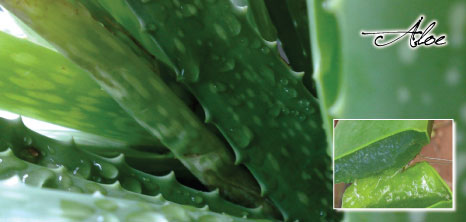|
AloeAncient history tells us that mankind has been enjoying the therapeutic benefits and the healing properties that have been associated with the Aloe Vera (Aloe barbadense) plant for more than 5,000 years. The Aloe Vera plant has been used for medicinal purposes to heal a variety of conditions, most notably burns, wounds and skin irritations.
The leaves of the Aloe plant tend to be organised in a rosette manner and are large, thick, fleshy and lance-shaped with a sharp apex and serrated edges. Aloe flowers are tubular, frequently yellow, pink or red and are borne on densely clustered, simple or branched leafless stems.
Many species of the Aloe plant in Barbados tend to be stemless, with the rosette growing directly from ground level. Varieties include from grey to bright-green and are sometimes striped or mottled along with the being plain.
The Aloe leaf structure is made up of four layers: the Rind, the Sap, The Mucilage Gel and Aloe Vera.
The Rind is the outer protective layer of the plant
In its raw state, the Aloe Vera plant has a bitter taste but can easily be digested with the help of your favourite fruit juice.
As per the rest of the world, the Aloe plant is quite beneficial in Barbados. Amongst its medicinal benefits and soothing properties, many mothers and grandmothers have applied this plant on to the thumbs of young children so as to have a deterrent effect on their 'bad' thumb-sucking habits.
Healing Properties of the Aloe Vera PlantThe gel of the Aloe plant is 99% water but it also contains substances known as Glycoprotein and Polysaccharides that speed the wound-healing process via cell proliferation and repair. Aloe gel also contains a total of 75 different substances including vitamins, minerals, enzymes, sugars, anthraquinone or phenolic compounds, lignin, saponins, sterols, amino acids and salicylic acid.
The Aloe plant, often referred to as Nature's Silent Healer or Miracle Plant is renowned for its magical healing power with the majority of its healing abilities being attributed to its extracted juice. Medicinal benefits of the Aloe plant are as follows:-
Care of the Aloe Vera PlantBased on the fact that over 90% of the Aloe Vera plant consists of water, when planted outdoors, they should be exposed to full sunlight or partial shade with moderately fertile and well-draining soil. The practice of having Aloe plants indoors is not one that is common on the island of Barbados but in the event this is preferred, the plant should be near a window that offers it lots of sunlight. The root system of the Aloe plant is a shallow, spreading one and as such chosen pots should be wider as opposed to deeper.
|



